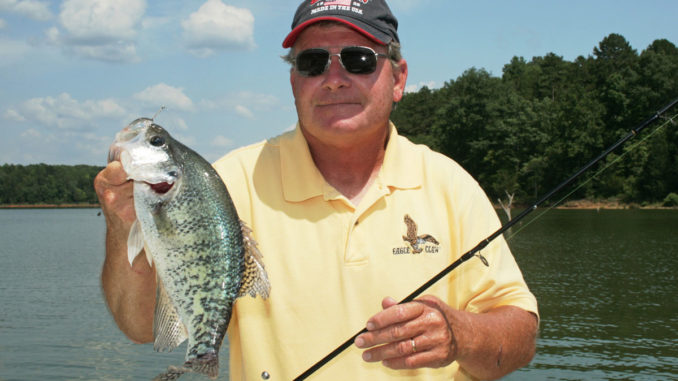
Three guides know the ticket to catching more crappie after the spawn. Their ideas should help you put more fish in the boat on several South Carolina lakes.
When crappies make their rush to spawn in the shallows in lakes across South Carolina, hordes of anglers hungry for fillets follow their every move. With the spawning process complete, fish reverse the migration and turn back toward deep water — but few anglers follow them on the return trip.
Crappies are still available and more than willing to bite, but different tactics and a bit of deep thinking are required, specifically deep thinking as it relates to fishing deeper water once fish leave the shallows.
South Carolina is home to all kinds of lakes that harbor scads of huge crappies. With the water warming, a fish’s metabolic rate increases rapidly, along with the need to feed. Armed with knowledge of how, when and where to fish, anglers can catch crappies right through the post-spawn as they migrate to their deep, summer homes. We’ll take a look at three extremely productive crappie lakes and the productive techniques for post-spawn crappie fishing at each.
Lake Wylie
Lake Wylie has been producing excellent crappie fishing in recent years, according to guide Jerry Neeley, who has fished the Catawba River reservoir on the North Carolina-South Carolina border for more than 55 years and guiding since 1995.
He knows the patterns crappie follow as they progress into the post-spawn phase, and he fishes the lower end of the lake, much of it in South Carolina, right through the post-spawn period, with great success.
“Catching limits of crappie is a realistic goal during the post-spawn on Lake Wylie,” Neeley said. “The fish are not as large as what we get in the prespawn and spawn, but we’ll still catch plenty of big crappie, with fish in the 2-pound class not unusual.
“The post-spawn pattern at Wylie is quite predictable and offers the opportunity to catch limits of quality crappie. I fish the lower end of the lake a lot this time of year and have developed a distinct pattern for catching crappie. My go-to-technique is trolling multiple rigs in large creeks on the lower end.”
Neely (704-678-1043) will typically begin his fishing days this month in the back of major creeks such as Allison, Crowder and Mill. He’ll also work points and humps off smaller creeks on the main Catawba River channel.
“I usually start early, right at dawn,” Neeley said. “I’ll take advantage of the low-light situation because crappies are feeding then and usually in shallower water than they will be in by mid-morning. I’ll troll from the back of the creeks toward the mouth, which keeps me fishing progressively deeper water until I hit the pattern of that day. Once that occurs, I fish that area hard until the action slows. On some days, we’ll limit in one general area, but on others trips, I’ll continue working down the creek until I get on fish again.”
Neely finds reasonably consistent patterns this month, but occasionally, a productive area one day won’t produce well the next, and he’ll quickly move to another creek or area.
“I’m a graph-watcher, and I need to see activity on my graph — and be catching fish consistently — to stay in an area,” he said. “Often, all that’s needed is to move to another creek to get on active fish.”
Neeley uses a variety of jig colors when trolling and searching for the right pattern, but one thing he always does is add a live minnow to the back of his jig.
“I use the live minnow addition year-round when trolling,” he said. “I’ve crappie fished for 55 years and experimented with every imaginable tactic, but putting a minnow on the jig consistently improves my success when trolling. I can catch crappie on jigs without adding minnows, but I do catch more and larger fish with them. It’s one of those no-brainers for me.”
Lake Marion
The post-spawn crappie bite on Lake Marion is a bit of a moving target in terms of the right depths, but the basic pattern is working woody cover, with fish moving progressively deeper until they lock into the summer pattern by the end of May. But lots of crappies, including plenty of slabs, are caught fishing deeper water.
Veteran guide Buster Rush said he actually prefers post-spawn fishing over the spawning period because patterns are more consistent.
“When fish are shallow, in the spawning stage, they are highly susceptible to cold fronts and normal movements as they spawn, often making them difficult to pinpoint,” he said. “With so much great cover in the shallow water at Lake Marion, they have a lot of options. As they move back to deeper water after spawning, I can consistently find them on deeper brush, stumps and logs.”
Rush (803-432-5010) said fishing in May requires anglers to search for the right depth on any given day. Early in the month, fish have left the shallows but have not fully locked into the deep-water, midsummer patterns. The best areas, he said, are along drops and ledges near deeper water.
“The typical pattern for May is to use my graph to find cover and fish congregated in water than will be anywhere from 8 down to 16 feet deep,” he said. “Fish are not in the really deep water at this time of year, but having deeper water nearby is something I look for. The depths fish are found are impacted significantly by time of day — specifically in terms of the low-light conditions of early morning and late evening — as well as cloudy days. Often, in low-light times, crappie will be shallower and sometimes more aggressive. When I mark crappie on the graph holding over the top of brush and along the sides, not buried in the middle of the cover, we’ll usually catch several fish quickly from that spot.”
Rush’s preferred technique is fishing vertically with live minnows using a 10- to 12-foot rod rigged with a single-hook tight-line rig. He’ll use a No. 3 split-shot to get the minnow to a precise depth, pulling line off his reels in 2-foot increments to ensure the bait is at or slightly above the depth fish are marked. Crappies will readily feed up, he said, but seldom down.
“This also keeps the lure out of the brush, meaning we’ll have less snags and tangles to deal with,” he said.
Sometimes fish will suspend well above deeper brush in May.
“If I don’t get bites quickly, I’ll usually lift the rod to change the depth, and I’ll pull the minnow up a bit searching for crappie suspended above the brush,” he said. “Occasionally, crappie will actually suspend a few feet above the top of the brush.”
Lake Russell
Lake Richard B. Russell on the Savannah River along the South Carolina-Georgia border seems made for crappie fishing with abundant woody cover available. With the spawn finished, crappie-fishing patterns change from either trolling shallows or long-pole, minnow-dunking techniques to deeper patterns. Most of the fish are holding in major tributaries off points and along ledges, orienting to wood and baitfish.
Guide Wendell Wilson said the action is wide open at Russell in May, but the number of anglers drops dramatically after the spawn.
“The key to catching crappie now is to fish in water 12 to 25 feet deep along the major tributary creek channels or in coves right off the main Savannah River channel,” Wilson said. “By late May and through the summer, we’ll have plenty of crappie pulling out onto main-lake points, humps and ledges as well.”
Wilson said crappie will be locked into this pattern through the summer and fall. Another crucial element is the crappies are very forage oriented and following shad. Find the shad coupled with woody cover, and you’ll find good crappie fishing.
Wilson (706-283-3336) said the fishing for the crappie is good early and late in the day in slightly shallower water, but crappie can be caught throughout the day.
“I use a slip-float rig early and late during low-light conditions to catch crappie shallower,” Wilson said. “I’ll target brush, stumps or trees where the tops of the trees rise up to about 10 to 12 feet deep. I also look for shad nearby, and that creates the ideal combination for catching crappie.
“With the fairly clear water we typically have by May, I’ll back off my target when fishing this depth and cast a slip-float rig that allows the minnow to drop to 8 to 10 feet deep, just above the top of the brush or trees. I’ll use small, live threadfin shad or tuffy minnows as bait. As the sun gets higher, I’ll fish deeper along the brush or trees near the bottom using a tight-line rig. We’ll catch occasional crappie up to 2 pounds, but the average size will be about a pound.”
Wilson said the average depth crappies are found gets progressively deeper as the water warms and clears. By the end of May many of the fish will be holding in the 20- to 25-foot depths, typical for the summer crappie pattern on Russell.

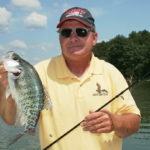
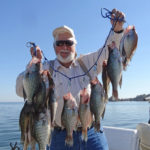
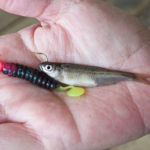
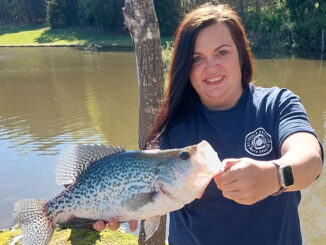
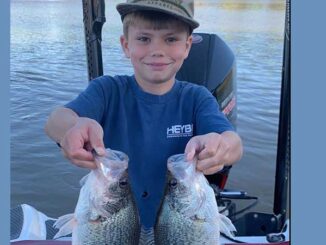
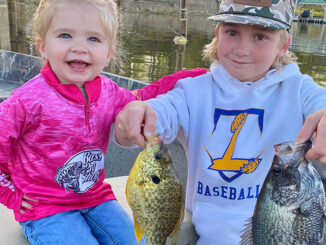

Be the first to comment